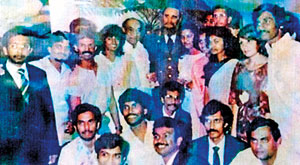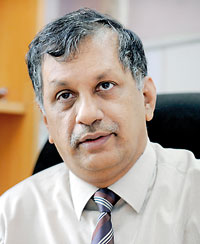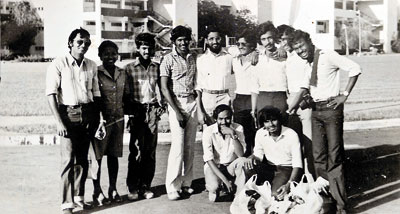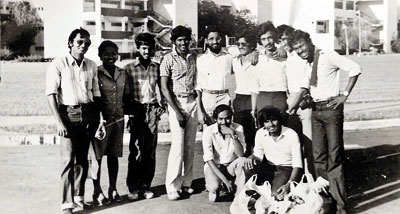Sunday Times 2
Castro, JR and Lankan students
View(s):By Kumudini Hettiarachchi
Some loved him but others hated him. Whatever the admirers or the critics may say, as the motorcade carrying the ashes of Cuba’s revolutionary leader Fidel Castro wended its way from Havana, the capital, to Santiago de Cuba where he will be laid to rest in a private funeral today, thousands of miles away in another tiny island, it is a nostalgic journey down memory lane for a large number of Sri Lankans.

Cuban Leader Fidel Castro and Sri Lanka’s President J.R. Jayewardene with the Sri Lankan students in Havana in October 1985. Young Ananda wearing a pair of spectacles is seated in front of Castro, while Nuwan (standing) is the second from the left
Pulling numerous frayed and fading photographs from old albums, these Sri Lankans in wide and varied professions spread across this country as well as the world are re-living their “days, months and years” in Cuba and the unforgettable meeting with Castro back in the 1980s.
 As they gather at the Cuban Embassy to bid a fond adieu to Castro today, they will go back in time to their student days, when Cuba gave them everything and more than they needed and moulded and nurtured them to be what they are now. From the late 1970s up to now, each year five youth head for Cuba on full scholarships to study medicine, engineering, sports medicine, veterinary science, physiotherapy, food technology, agricultural science, economics etc. A special quota of 20 scholarships had been granted to Sri Lanka in 1986-87.
As they gather at the Cuban Embassy to bid a fond adieu to Castro today, they will go back in time to their student days, when Cuba gave them everything and more than they needed and moulded and nurtured them to be what they are now. From the late 1970s up to now, each year five youth head for Cuba on full scholarships to study medicine, engineering, sports medicine, veterinary science, physiotherapy, food technology, agricultural science, economics etc. A special quota of 20 scholarships had been granted to Sri Lanka in 1986-87.
“Go back to your country and do your best,” is what Castro told these fresh-faced students who had come over to Cuba to pursue different spheres of undergraduate studies.While they looked on in awe, he had also assured then Sri Lankan President J.R. Jayewardene, who was on a brief visit to Havana that unlike students who seek higher education in western capitals, all the students who come to Cuba will return home to serve their country.
It was soon after the 8th Commonwealth Heads of Government Meeting in Nassau, the Bahamas, from October 16-22, 1985, 31 years ago that President Jayewardene paid a visit to Cuba to be greeted by a whole gang of students waving the flag of Sri Lanka and shouting “Jayawewa”. He had been so surprised at the large number that he walked across to them and asked them whether they were really from Sri Lanka or were in fact Cuban students brought to welcome him.
The welcoming role over, when the students went back to their respective universities, had come the call inviting them to the dinner that Castro was hosting for President Jayewardene at the President’s Palace in Havana.

The Sri Lankan flag is held high by Ananda along with a huge photo of Castro in Havana on May Day 1986, while Nuwan in a white cap is seated in a photograph snapped in front of the Revolutionary Palace in Cuba

Engineer Nuwan Kumarasinghe
The students, with wide smiles, flanking President Jayewardene and Castro, standing tall sporting his signature beard but no cigar or trademark fatigues, are captured on camera, a treasured photograph among the memories of their time in Cuba. (Castro who died aged 90 on November 25 ruled Cuba from 1959, heading the government till 2008)
“I didn’t even know where Cuba was when I was told that I had been awarded a scholarship to go there and study medicine,” the Medical Officer-in-Charge of the Accident Service of the Lady Ridgeway Hospital for Children, Dr. Ananda H. Angammana tells the Sunday Times. It was then that he looked up a map, no easy Google being available in 1980.
Along with him went four others to Cuba, two to do medicine and two to do engineering. The air-fare was Rs. 13,000, a princely sum for a boy from Angammana village in Gampola. “That was the only cost. For, once we landed in Cuba, every single thing was provided,” says Dr. Angammana, describing how they were immediately taken to a poly-clinic in Havana for a week to be screened for diseases such as malaria and filaria and then given a dose of chloroquine to ward off malaria which made them drowsy and sick. The food was quite different to Sri Lanka – lots of fish and meat and a little rice but cooked differently.
Next came a long bus ride to the University of Santa Clara, 300kms away, through landscapes very similar to Sri Lanka, to study Spanish, the language of the locals, for one year. They also saw vast tracts of sugarcane cultivations, with land utilisation to a maximum, unlike back home. There were no houses spotting the landscape, breaking up the cultivable areas. The homes were clustered around one area surrounded by all the required facilities.
 “Everything was provided to the scholarship holders by the Cuban government under the charismatic leadership of Castro,” says Dr. Angammana, going into great detail……accommodation, all medical books, food, clothes (both the uniforms for university and other clothes including sweaters to face the cooler season), shoes and also the airfare to come back to Sri Lanka after their studies.
“Everything was provided to the scholarship holders by the Cuban government under the charismatic leadership of Castro,” says Dr. Angammana, going into great detail……accommodation, all medical books, food, clothes (both the uniforms for university and other clothes including sweaters to face the cooler season), shoes and also the airfare to come back to Sri Lanka after their studies.
Similar sentiments are expressed by engineer Nuwan Kumarasinghe attached to the Meteorology Department, focusing on Castro who was from a wealthy landowning family but gave up all that once he took up the cause of his country.Mr. Kumarasinghe, however, knew a little bit about Cuba having followed the Non-aligned Summit held in Sri Lanka in 1976, which Castro was unable to attend and sent his Foreign Minister to represent him.
Each and every student, not only from Sri Lanka but also from Africa, other parts of Asia, Latin America and even a few who had come over from the United States of America (although the US and Cuba were daggers drawn and in the midst of the Cold War, with hardships being piled on Cuba by the economic embargo imposed by the US) were given 60 pesos as pocket-money monthly. The students were also looked after during the holidays, taken to the beach or to the plantations to spend their leisure time or have fun at the fiestas that Cubans who are a jolly people held often.
Two tins of condensed milk were issued per student per month, as well as two packets of cigarettes, says Dr. Angammana, promptly adding that not a single Sri Lankan student smoked, so they exchanged them for more condensed milk.
“All this was given without any expectations from us by the Cuban authorities,” he says, reminiscing how they would study and study, spreading their books all over their beds, as there were no other distractions. They also became disciplined, able to manage on their own, as they had to clean and mop their rooms and toilets themselves.
None of them engaged in politics — not in Cuba neither back home in Sri Lanka.
Dr. Angammana stayed seven long years – learning Spanish for one year, medicine for five years and doing his internship for another year. He never telephoned his family back in Sri Lanka because international calls were entangled in difficulties those days. Letters sent air-mail were the only link, that too taking about one and a half months to reach, in those days sans computers, e-mails and mobile phones.
Mr. Kumarasinghe, meanwhile, learnt Spanish and then went onto study electronic engineering at the Jose Antonio Echeverria Technical University, also of the University of Havana. Castro’s vision was to provide health for all and also education, he says, adding that his university had two sessions. In the morning session regular students would occupy the lecture halls while in the evening any worker could come in, pore over the lessons and secure a degree.
He remembers a critical time in Cuba, when it was in the stranglehold of a dengue epidemic. “A massive campaign was launched by Castro who participated along with the people to clean up Cuba of mosquito-breeding sites, while encouraging research on biological control agents to eradicate dengue.” Cuba is also conscious of its obligations to other countries and send their doctors to work at the grassroots.
Dr. Angammana adds that for every 120 families there is a doctor who looks after all members, the young and the old. Even animals such as dogs and cats that belong to a family are registered and vaccinated. There is a very strong health system in place. The grassroots-level doctors would refer anyone who needs tests to a poly-clinic and from there a referral would follow to a bigger hospital if required.
For all the students who have had the opportunity to study in Cuba, meanwhile, Castro’s death is like the loss of a family member for their second home now is the Cuban Embassy in Sri Lanka. Castro was frank with his people, telling them the truth and putting words into action, says Mr. Kumarasinghe, while Dr. Angammana adds that Castro knew everything even about the foreign students. “He was like a father to us,” he says with emotion.

